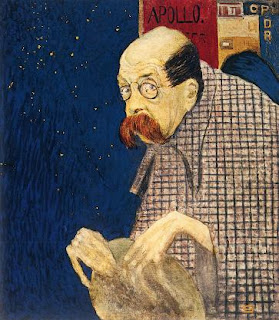 by Derry Nairn
by Derry NairnA fantastic new exhibition at London's Wellcome Collection charts the sometimes blurred line between artistic genius and insanity. Madness & Modernity focuses on how the issue of mental illness was broached in fin de siécle Vienna. This was a period of artistic flux in Austria's imperial capital, with radical departures from tradition felt across the arts.
Prominent artists of the day crossed paths with mental illness. The first room opens, for example, with a trio of spookily deranged busts by the sculptor Messerschmidt. Next the viewer can observe the grandiose Steinhof sanatorium, 'the city on a hill', built by one of the most celebrated modernist architects of his day, Otto Wagner.
Portraitists such as Egon Schiele and Oskar Kokoschka broke from the norm by depicting their subjects in contorted, often spasmodic positions. Not least of these subjects was Schiele himself who, in a series of famous self-portraits, portrayed his own body in a range of painfully angular poses.
The curators of Madness & Modernity have chosen to display Schiele's work alongside photos of sanatoria inmates. These are taken from contemporary psychological journals which were widely circulating among Viennese artists as source material at the time. The hint is of a canny rather than an unhinged artist, choosing to portray himself in such a fashion, and in the process tapping into an general fascination with mental illness among his peers.
Other rooms boast a Kokoschka portrait, a set of spellbindingly colourful minature paintings by a sanatorium inmate, and studies by Freud - which contrast his mind-centred approach to the 'bodily whole' cures of the original electrotherapy equipment sitting nearby.
It was the penultimate room which captivated me the most, however. Here, two lesser heroes of Vienna's early 20th century artistic renaissance are remembered: Max Oppenheimer and Peter Altenberg. Oppenheimer's works are studies in the disturbed mind, in spite of their subjects' perfect sanity. The caricature of Peter Altenberg (see above), cap in hand with wild eyes and wringing hands, shows an artist who not only insisted on such depiction, but cultivated it. He had spells in sanatoria, slept through freezing winters with windows wide open, and maintained a permanent table at Vienna's famous Cafe Central, receiving both post and visitors there like a private office.
Madness, then, became a central tenet for this set of artists. This fascinating show at the Wellcome Collection suggests that mental faults of one type or another - addiction, obsessiveness, insomnia - continue to mascarade as self-identity. This has been the enduring contribution to contemporary culture of an extraordinary time and place.

No comments:
Post a Comment